Macapuno
Macapuno, kopyor or coconut sport is a naturally occurring coconut cultivar which has an abnormal development of the endosperm. The result of this abnormal development is a soft translucent jelly-like flesh that fills almost the entire central cavity of coconut seeds, with little to no coconut water.[1] Macapuno was first described scientifically from wild specimens in 1931 by Edwin Copeland. They were first cultivated commercially in the Philippines after the development of the "embryo rescue" in vitro culture technology in the 1960s by Emerita V. De Guzman. It has become an important crop in coconut-producing countries and is now widely used in the cuisines of Southeast Asia, South Asia, and the Pacific Islands.
.jpg)
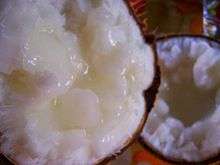 The endosperm of macapuno coconuts are jelly-like and fill almost the entirety of the central cavity in coconut seeds | |
| Alternative names |
|
|---|---|
| Place of origin | Philippines |
| Region or state | Southeast Asia, South Asia, and the Pacific Islands |
| Associated national cuisine | Philippines |
| Main ingredients | Coconut |
Name
The name macapuno (also spelled makapuno) is derived from Tagalog makapuno, the local name of the phenotype in the Philippines, meaning "characterized by being full", a reference to the way the endosperm in macapuno coconuts fill the interior hollow of coconut seeds.[2] It is also known as kopyor in Indonesia and Malaysia, dong kathi in Cambodia, thairu tengai in India, niu garuk in Papua New Guinea, pia in Polynesia, dikiri pol in Sri Lanka, maprao kathi (Thai: กะทิ) in Thailand, and dừa sáp ('wax coconut') in Vietnam.[3]
Characteristics
It is impossible to distinguish macapuno seeds from normal seeds from the external appearance of the fruits. The only way to ascertain if a seed has the macapuno phenotype is to open it.[4]
Normal coconut flesh mostly consists of galactomannan as a source of energy. In the development process, this substrate is degraded into two sub-components, galactose and mannose. In macapuno, the enzyme for degrading this substrate, α-D-galactosidase, is not active. Hence, the endosperm fails to nourish the embryo, resulting in a collapsed embryo. Besides this enzyme, a couple of other enzymes are also suspected of being involved in the development of this trait: sucrose synthase and stearoyl acyl carrier protein desaturase.[4]
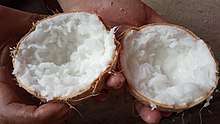
Macapuno coconuts have a higher sucrose proportion (92% of total sugar) and contain more total amino acids compared with young mature coconuts. The lipid content in the flesh is also lower compared to young mature coconut flesh. In addition to the higher content of citric and malic acids, all these properties may contribute to the taste of macapuno flesh.[5]
Macapuno are classified into three types (I, II, and III), depending on how much the soft endosperm fills the seeds.[6]
Cause
The macapuno phenotype is believed to be controlled by a recessive gene (m) expressed as a homozygous condition in wild macapuno-bearing palms. This would explain why naturally-occurring macapuno palms bear both macapuno seeds and normal seeds, as pure macapuno palms would be impossible in the wild. Laboratory experiments have also shown that self-pollinated or cross-pollinated rescued macapuno embryos result in pure macapuno palms that have 100% macapuno seed yields, reinforcing the hypothesis. The presence of the dominant gene M would produce normal viable coconuts. The xenia effect may also play a factor in the expression of macapuno phenotypes.[4]
| Egg nucleus (n) | Polar nuclei (2n) | |||
|---|---|---|---|---|
| Sperm nucleus (n) | M | m | MM | mm |
| M | MM Germinating embryo |
Mm Germinating embryo |
MMM Normal endosperm |
Mmm Normal endosperm |
| m | Mm Germinating embryo |
mm Non-germinating embryo |
MMm Normal endosperm |
mmm macapuno endosperm |
History of cultivation
Macapuno occurs sporadically in the wild at very low rates of 0.15% throughout the native range of Pacific coconuts.[3] It occurs in palms which bear both the macapuno and normal seeds. Macapuno was initially reported in scientific literature in 1931 by Edwin Copeland, an American botanist working for the Department of Agriculture of the Insular Government of the Philippine Islands (then an American territory). The original specimens were described from Laguna, Philippines and Java, Indonesia.[9][4]
Macapuno remained rare and expensive, despite being valued as a traditional delicacy, because macapuno seeds are non-viable. While the embryos of macapuno seeds are normal, the surrounding abnormal endosperm can not support their germination, thus rendering macapuno seeds effectively sterile.[6][10] Traditional propagation of macapuno involved taking the viable (normal) seeds from the same racemes as macapuno seeds and planting them.[11] While macapuno yields could be increased by planting macapuno-bearing palms close together or in isolation, the chances of the phenotype reoccurring in the fruits of the progeny was very low, at only 2 to 21%.[6]
Mass propagation of macapuno seedlings only became possible through the development of "embryo rescue" in vitro culture technology by the Filipina plant physiologist Emerita V. De Guzman of the University of the Philippines in the 1960s.[4][6][12] By extracting ("rescuing") the embryo inside macapuno seeds and culturing them in vitro, she was able to increase macapuno yields per palm to 75 to 100%. This technology was later improved in the 1990s by the Albay Research Center of the Philippine Coconut Authority (PCA-ARC) headed by the Filipina biotechnologist Erlinda P. Rillo.[13][4]
Four other improved protocols for coconut embryo culture technology were further developed by the PCA-ARC, University of the Philippines Los Baños (UPLB), the Central Plantation Crops Research Institute (CPCRI) of India, and the Institut de recherche pour le développement (IRD) of France. These were tested by fourteen laboratories in eleven countries (China, India, Indonesia, the Philippines, Papua New Guinea, Sri Lanka, Vietnam, Brazil, France, Mexico, and Tanzania) in the 1997 global Coconut Embryo Culture Project. These protocols were later combined into the improved embryo culture protocol by Areza-Ubaldo, et al. (2003) of the PCA and is now the primary method of mass-producing macapuno seedlings in coconut-producing countries.[14][15]
Culinary uses
In Filipino cuisine, macapuno is widely used and is popular for its sweet coconut flavor. It can be eaten on its own or used as an ingredient in traditional desserts like halo-halo and pastillas or cooked in syrup as a minatamis (fruit preserve). It is also used widely in processed food products, including ice creams, pastries, cakes, candies, and beverages. A traditional combination in Filipino cuisine that is also a common flavoring in various desserts is macapuno and ube halaya (mashed purple yam), a pairing known as "ube macapuno".[16]
In Indonesian cuisine, macapuno coconut (kelapa kopyor) is considered a delicacy. Es kelapa kopyor is a dessert drink which is usually made using this coconut.
In Vietnam, macapuno is grown in Tra Vinh and Ben Tre provinces and is an expensive delicacy. Its flesh is mixed with milk and crushed ice to make a smoothie and served with crushed toasted peanuts.[17]
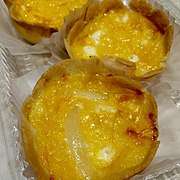 Macapuno tarts from the Philippines
Macapuno tarts from the Philippines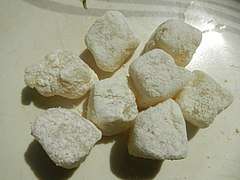 Macapuno pastillas from the Philippines
Macapuno pastillas from the Philippines- Ube macapuno pianono from the Philippines
 Halo-halo with macapuno strips from the Philippines
Halo-halo with macapuno strips from the Philippines.jpg) Macapuno ice cream in California
Macapuno ice cream in California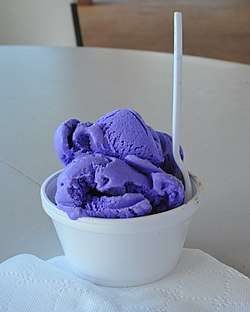
- Es kelapa kopyor from Indonesia
See also
| Wikimedia Commons has media related to Macapuno. |
- Nata de coco, another coconut product developed in the Philippines
- Coconut sprout
References
- Sukendah; Volkaert; Sudarsono (December 2009). "Isolation and Analysis of DNA Fragment of Genes Related to Kopyor Trait in Coconut Plant". Indonesian Journal of Biotechnology. 14 (2): 1169–1178.
- Padilla, Leila Denisse E. (2013). "Makapuno, the good mutant". BAR Chronicle. 14 (9). Retrieved 21 April 2019.
- Chomchalow, Narong (2013). "Curd Coconut: Its Mystery and Potentialities". AU Journal of Technology. 16 (3): 153–158.
- Angeles, Jorge; Lado, Jickerson; Pascual, Evangeline; Cueto, Cristeta; Laurena, Antonio; Laude, Rita (2018). "Towards the Understanding of Important Coconut Endosperm Phenotypes: Is there an Epigenetic Control?". Agronomy. 8 (10): 225. doi:10.3390/agronomy8100225.
- Santoso, Umar; Kubo, Kazuhiro; Ota, Toru; Tadokoro, Tadahiro; Maekawa, Akio (October 1996). "Nutrient composition of kopyor coconuts (Cocos nucifera L.)". Food Chemistry. 57 (2): 299–304. doi:10.1016/0308-8146(95)00237-5.
- Rillo, Erlinda P. (1999). "Coconut embryo culture". In Oropeza, C.; Verdeil, J.L.; Ashburner, G.R.; Cardeña, R.; Santamaría, J.M. (eds.). Current Advances in Coconut Biotechnology. Current Plant Science and Biotechnology in Agriculture. 35. Springer Netherlands. pp. 279–288. doi:10.1007/978-94-015-9283-3_20. ISBN 9789401592833.
- Torres, J. (1937). "Some notes on macapuno coconut and its inheritance". Philippine Journal of Agriculture. 8: 27–37.
- Zuñiga, L.C. (1953). "The probable inheritance of the macapuno character of the coconut". Philippine Agriculture. 36: 402–413.
- Copeland, Edwin B. (1931). The Coconut. Macmillan and Company, Ltd.
- Blake, Jennet (1995). "A brief history of coconut tissue culture". In C., Oropeza; F.W., Howard; G.R., Ashburner (eds.). Lethal Yellowing: Research and Practical Aspects. Developments in Plant Pathology. Volume 5. Springer Netherlands. pp. 195–201. doi:10.1007/978-94-011-0433-3_16. ISBN 9789401104333.
- Albay Research Center. Makapuno Embryo Culture Technology (PDF). Philippine Coconut Authority, Department of Agriculture, Republic of the Philippines. Retrieved 21 April 2019.
- "Scientist Profile: Emerita V. De Guzman". SPHERES (Specialized Philippine Enterprise Reference of Experts and Scientists). Department of Science and Technology, Republic of the Philippines. Retrieved 21 April 2019.
- "Scientist Profile: Erlinda P. Rillo". SPHERES (Specialized Philippine Enterprise Reference of Experts and Scientists). Department of Science and Technology, Republic of the Philippines. Retrieved 21 April 2019.
- Areza-Ubaldo, Maria Buena B.; Rillo, Erlinda P.; Cueto, Cristeta A. (2003). "Application of the Improved Embryo Culture Protocol for Commercial Production of Makapuno Seedlings" (PDF). Philippine Journal of Science. 132 (1): 1–11.
- IPGRI in Asia, the Pacific and Oceania: Regional Report - APO 1999-2000. International Plant Genetic Resources Institute. 2001. pp. 10–11. ISBN 9789290434931.
- Veneracion, Connie (2006-10-07). "Ube – macapuno dessert". Casa Veneracion. Retrieved 27 March 2019.
- "Cau Ke Makapuno". 2018-05-31.
